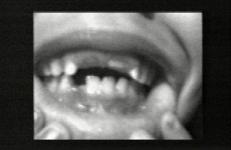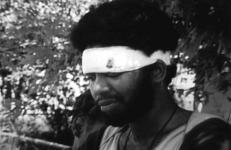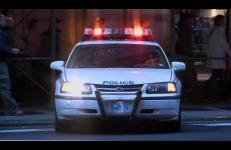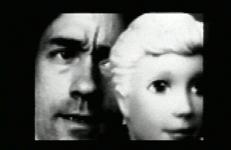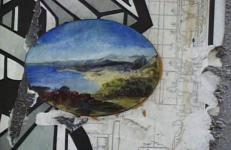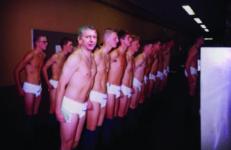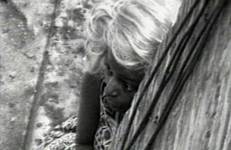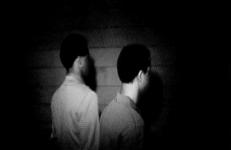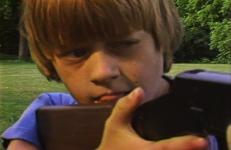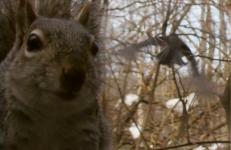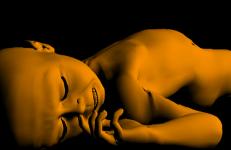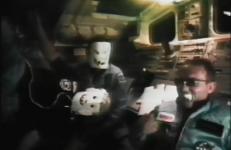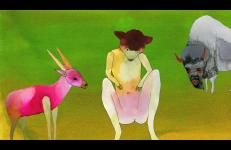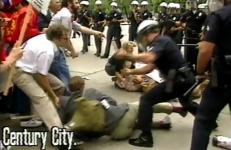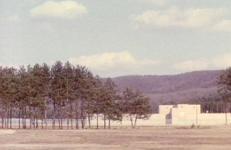“Nicky is seven. His parents are older and meaner.” A Place Called Lovely references the types of violence individuals find in life, from actual beatings, accidents and murders, to the more insidious violence of lies, social expectations, and betrayed faith. Benning collects images of this socially-pervasive violence from a variety of sources, tracing events from childhood: movies, tabloids, children's games (like mumbledy-peg), personal experiences, and those of others.
Crime or Violence
Playing Dead is a film about lying still to stay alive. A news reporter queries the survivor of a brutal attack.
This title is only available on Broad Daylight and Other Times: Selected Works of Kevin Jerome Everson.
The crowded streets of New York City turn into fictive, cinematographic scenery. Provost is playing with our collective memory, its cinematic codes and narrative languages - questioning the boundaries between a staged, suggested reality and authentic fiction. Although filmed with a hidden camera, Plot Point presents a highly dramatic construction with overly sophisticated images and a subtle but tangible urge in the soundtrack.
Tension between a man and his handsome young rival (a Ken doll) erupts into violence. Their interaction devolves from a series of tussles to a spanking.
This title is also available on Joe Gibbons Videoworks: Volume 1.
Public Discourse is an in-depth study of illegal installation art. The primary focus is on the painting of street signs, advertising manipulation, metal welding, postering and guerrilla art, all performed illegally. Public Discourse is about passionate artists who want their work to be seen by a wide range of people rather than be confined to the systemic structures of galleries and museums.
Public Discourse is an in-depth study of illegal installation art. The primary focus is on the painting of street signs, advertising manipulation, metal welding, postering and guerrilla art, all performed illegally. Public Discourse is about passionate artists who want their work to be seen by a wide range of people rather than be confined to the systemic structures of galleries and museums.
Public Discourse is an in-depth study of illegal installation art. The primary focus is on the painting of street signs, advertising manipulation, metal welding, postering and guerrilla art, all performed illegally. Public Discourse is about passionate artists who want their work to be seen by a wide range of people rather than be confined to the systemic structures of galleries and museums.
Based on a set of drawings that depict George W. Bush's administration as wounded soldiers in the war against terrorism, RE:THE_OPERATION explores the sexual and philosophical dynamics of war through the lives of the members as they physically engage each other and the "enemy." Letters, notes, and digital snapshots "produced" by the members on their tour of duty become the basis of video portraits that articulate the neuroses and obsessions compelling them toward an infinite war.
In response to BLM events and to the whole world of injustice, slaughter and abuse... a small comment.
–– Ken Kobland
Loosely based on the 1950s British detective film Sapphire, in which two Scotland Yard detectives investigate the murder of a young woman who is passing for white, Sapphire and the Slave Girl examines the determinants of Sapphire's murder investigation through its cinematic representation.
Second and Lee is a cautionary tale about when not to run. It uses archival reportage and voiceover recollection to trace through repetitive corridors of presumption, justice and judgment.
Smothering Dreams is a tough, scathing condemnation of war and our country's fascination with violence. Reeves draws on his own experience as a U.S. Marine in Vietnam in the 1960s, juxtaposing actual combat footage, staged war games, and child’s war play to make his message horrifyingly clear. This work is dedicated to the men of the 3rd Platoon Company A 1st Amtrac Battalion and the North Vietnamese soldiers who died on January 20, 1969 along the Cua Viet River.
Songs of Praise for the Heart Beyond Cure is a fourteen-minute experimental video that unfolds through a series of short episodes. "To describe Cooper Battersby and Emily Vey Duke's new video as ironic doesn't do it justice.
Songs of Praise for the Heart Beyond Cure is a fourteen-minute experimental video that unfolds through a series of short episodes. "To describe Cooper Battersby and Emily Vey Duke's new video as ironic doesn't do it justice.
Prophecies of doom, disaster and political catastrophe envisioned by some of the world’s most famous psychics between the 1960’s and the year 2001 are conjured up through 3D-animation, industrial films, text and historical footage -- the sum of which combine to form a visually stunning meditation on the forces that are driving us into a dark, paranoid and uncertain future. Soothsayer reconsiders yesterday’s daunting and sometimes whimsical predictions for the future after they’ve been outpaced by time.
Space Ghost compares the experiences of astronauts and prisoners, using popular depictions of space travel to illustrate the physical and existential aspects of incarceration: sensory deprivation, the perception of time as chaotic and indistinguishable, the displacement of losing face-to-face contact, and the sense of existing in a different but parallel universe with family and loved ones.
Physical comparisons such as the close living quarters, the intensity of the immediate environment, and sensory deprivation, soon give way to psychological ones: the isolation, the changing sense of time, and the experience of earth as distant, inaccessible, and desirable. The analogy extends to media representations that hold astronauts and prisoners in an inverse relationship: the super citizen vs. the super-predator. Astronauts, ceaselessly publicized, are frozen in time and memory whereas prisoners, anonymous and ignored, age without being remembered.
Stardust is the second part of the trilogy where Nicolas Provost investigates the boundaries of fiction and reality by filming everyday life with a hidden high resolution camera and turning the cinematic images into a fiction film by using cinematographic and narrative codes from the Hollywood film language. The first part of the trilogy was the award winning Plot Point (2007) that was shot entirely with a hidden camera and turned everyday life around Times Square, New York into a thriller film.
An investigative documentary on police brutality that uses the Rodney King incident as a springboard to analyze the inner workings of the LAPD under the leadership of former police chief, Daryl Gates. Containing hard-hitting footage of police violence, the tape also depicts communities working against the daily occupation of their neighborhoods. Through interviews with LAPD officers and supervisors, the tape reveals what life is like behind the “thin blue line” and documents a national crisis of violence.
An investigative documentary on police brutality that uses the Rodney King incident as a springboard to analyze the inner workings of the LAPD under the leadership of former police chief, Daryl Gates. Containing hard-hitting footage of police violence, the tape also depicts communities working against the daily occupation of their neighborhoods. Through interviews with LAPD officers and supervisors, the tape reveals what life is like behind the “thin blue line” and documents a national crisis of violence.
I drove around the U.S. filming these super maximum-security prison buildings the spring and summer after the World Trade Center bombing. I knew that counties within various states had been frantically outbidding each other to get these high-tech gulags to replace the farming and manufacturing jobs that have been lost over the last 25 years. The timing seemed right to remind everyone what we have been doing with our public funding and to draw parallels with the neo-liberal economic policies espoused with variations by the Reagan, Clinton and both Bush administrations.
The Sun Quartet is a solar composition in four movements, a political composition in four natural elements, an audiovisual composition in four bodily mutations: a sun stone where youth blooms in protest, a river overflowing the streets, the burning plain rising in the city. And, finally, the clamor of the people that shook Mexico after the night of September 26, 2014. The disappearance of 43 students from Ayotzinapa opened a breach in the Mexican political body.
The Sun Quartet is a solar composition in four movements, a political composition in four natural elements, an audiovisual composition in four bodily mutations: a sun stone where youth blooms in protest, a river overflowing the streets, the burning plain rising in the city. And, finally, the clamor of the people that shook Mexico after the night of September 26, 2014. The disappearance of 43 students from Ayotzinapa opened a breach in the Mexican political body.
The Sun Quartet is a solar composition in four movements, a political composition in four natural elements, an audiovisual composition in four bodily mutations: a sun stone where youth blooms in protest, a river overflowing the streets, the burning plain rising in the city. And, finally, the clamor of the people that shook Mexico after the night of September 26, 2014. The disappearance of 43 students from Ayotzinapa opened a breach in the Mexican political body.
The Sun Quartet is a solar composition in four movements, a political composition in four natural elements, an audiovisual composition in four bodily mutations: a sun stone where youth blooms in protest, a river overflowing the streets, the burning plain rising in the city. And, finally, the clamor of the people that shook Mexico after the night of September 26, 2014. The disappearance of 43 students from Ayotzinapa opened a breach in the Mexican political body.
Subverting dramaturgical conventions in his Plot Point trilogy, Provost masterfully presents the man in the street as a film protagonist. After New York (Plot Point) and Las Vegas (Stardust) he takes his hidden camera to the hyperkinetic streets of Tokyo and reveals the mystery of reality. A serial killer, a rapist, a terrorist, a cult, the Yakuza, all have in common that their paths cross and merge into a powerful climax that can not be resolved.




